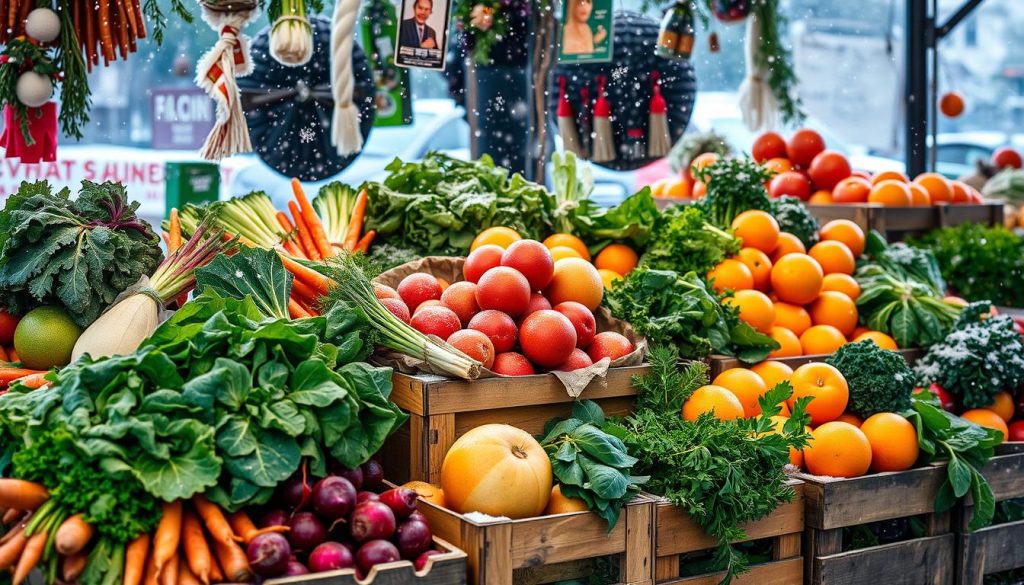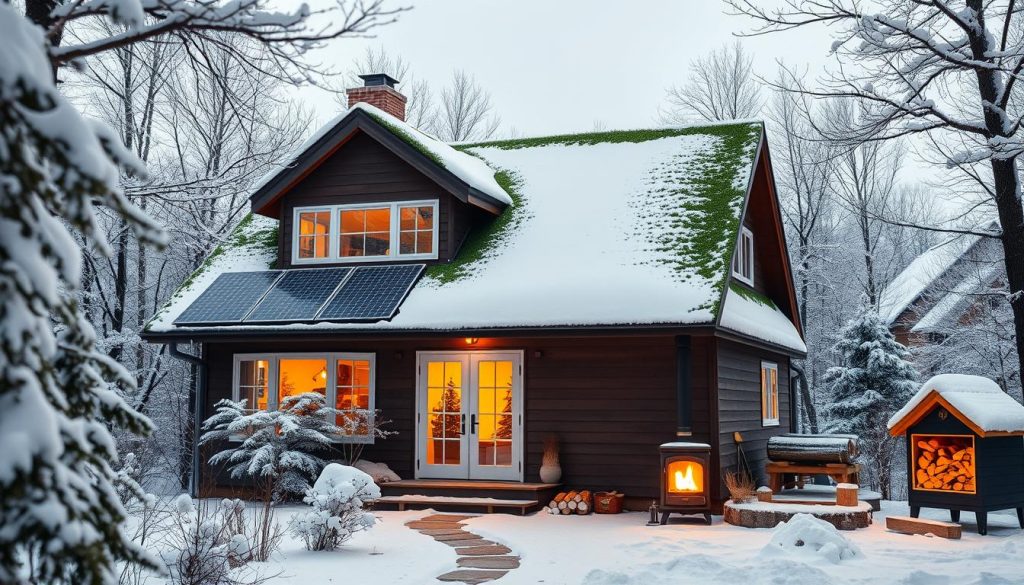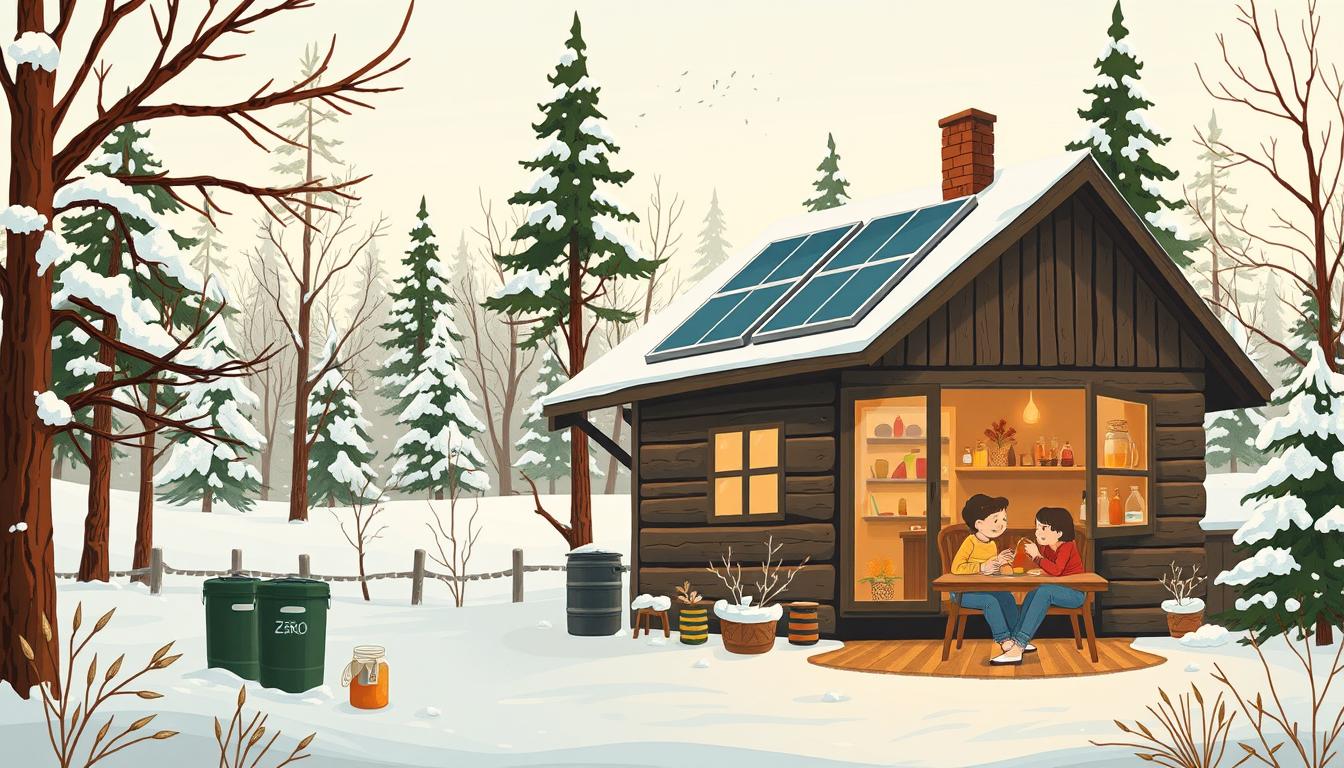Winter can make living zero waste seem hard, but it’s doable and fun. I’ll share my tips for less waste, saving money, and staying warm. This guide is packed with practical advice for a greener winter.
We’ll cover the basics of zero waste, making your home energy-smart, and smart shopping. You’ll find out about green heating, staying warm with layers, and joining local waste efforts. It’s all about making your winter more sustainable and cozy.
By the end, you’ll know how to live more sustainably and save money this winter. Let’s start this journey to a zero waste lifestyle together, step by step.
Understanding Zero Waste Principles
Starting my journey towards a sustainable lifestyle, zero waste guides me. It’s not just about cutting down trash. It’s about reducing my environmental impact through smart choices and creative reuse.
What Zero Waste Means to Me
Zero waste living means changing how I view everyday products. It’s about making choices that matter, choosing quality over quantity, and finding new uses for things. Winter brings its own set of challenges, making this mindset even more crucial.
The Importance of Sustainability
Sustainability drives my zero waste efforts. By using less and wasting less, I help the planet and support a better future. This is especially true in winter, when resources are tight and our actions count more.
Adopting zero waste principles has made my life more eco-friendly and rewarding. It’s about making small changes that make a big difference. I’m excited to see how it will change my Winter living and inspire others to live sustainably too.
Adapting My Home for Winter
Winter is coming, and it’s time to get our homes ready. We can make our homes warm and comfy while also helping the planet. This is done by focusing on energy efficiency and eco-friendly practices.
Energy Efficiency Tips
Improving our homes’ energy efficiency is crucial for winter. Simple steps can make a big difference. Here are a few:
- Seal air leaks around windows, doors, and openings to keep heat in.
- Make sure attics, walls, and crawl spaces are well-insulated to stay warm.
- Replace old windows and doors with energy-efficient ones to save heat.
- Use a programmable thermostat to heat your home only when needed.
Eco-Friendly Winter Decor
Decorating for winter can be fun, but let’s do it in an eco-friendly way. Here are some ideas:
- Use natural items like pinecones, dried flowers, and evergreen branches for decor.
- Choose reusable or biodegradable decorations, like cloth stockings or wooden ornaments.
- Try DIY projects to make unique, sustainable winter decorations from household items.
- Use LED or energy-efficient lights to brighten up our homes during the dark nights.
By making a few changes, we can make our homes cozy and eco-friendly. These tips and ideas are just the beginning. They help us prepare for winter while also caring for our planet.
Mindful Shopping During the Holidays

As winter holidays near, it’s key to live sustainably. This season, I’m choosing eco-friendly shopping and gifts. This way, I reduce waste and lower my environmental footprint, keeping the holiday spirit alive.
Choosing Eco-Friendly Gifts
I look for gifts that are good for the planet. I choose items made from renewable or recycled materials. I also support local and handmade goods to help small businesses and cut down on carbon emissions.
Reducing Wrapping Waste
Gift wrapping is a big part of the holidays, but it can be wasteful. I’ve found creative ways to wrap gifts, like using recycled materials or fabric. These choices not only cut down on waste but also make my gifts special and personal.
Local vs. Online Shopping
- I prefer shopping locally. It helps my community, cuts down on shipping emissions, and lets me find unique, green products.
- For things I can’t find nearby, I look for online stores that care about the environment and ship responsibly.
By being mindful of my holiday shopping, I help make the world a greener place. And I still get to enjoy the joy of the season.
Winter Meal Planning for Zero Waste

Winter is here, and it’s a great time to think about using seasonal produce and reducing kitchen waste. Planning meals with a zero-waste approach helps the environment, saves time, and money.
Using Seasonal Ingredients
Embracing seasonal produce is key in winter meal planning. Root veggies, hardy greens, and citrus fruits are not only nutritious but also cheaper. Using these ingredients supports local farmers, cuts down on food carbon, and brings out the best flavors of the season.
Creative Leftover Ideas
Reducing waste means getting creative with leftovers. Turn roasted veggies into soup or make croutons from extra bread. There are countless ways to reuse leftovers, cutting down on waste and saving time.
Winter meal planning can be easy and fun. Focus on seasonal foods and get creative with leftovers. This way, we enjoy tasty, eco-friendly meals while reducing our environmental footprint. Let’s dive into the zero-waste lifestyle and enjoy the winter’s flavors.
Keeping Warm Sustainably

Winter is here, and keeping warm without using a lot of energy is key. I’m looking into eco-friendly heating and smart layering to stay cozy. This way, I can enjoy my home without harming the planet.
Eco-Friendly Heating Options
Traditional heating can harm the environment and increase bills. I’ve found better ways to stay warm:
- High-efficiency heat pumps use electricity to move heat, not make it.
- Wood-burning stoves and fireplace inserts use renewable fuel.
- Geothermal heating uses the earth’s heat to warm my home.
Layering Clothing Tips
Clothing layering is also a game-changer for winter warmth. Here’s how I stay toasty:
- Start with moisture-wicking base layers to keep my body temperature steady.
- Then, add insulating mid-layers like sweaters or fleece to hold in heat.
- Finish with a waterproof outer layer to shield against wind and rain.
- Don’t forget warm socks, gloves, and hats to keep extremities cozy.
By using these energy-saving heating methods and layering tips, I stay warm and cut down on energy use. These habits are a big part of my eco-friendly lifestyle.
Engaging in Community Initiatives
My journey towards sustainable living has shown me the power of community. In winter, when it’s cold, joining local zero waste events and eco-friendly projects keeps me connected. It also lets me make a real difference.
Joining Local Waste-Free Events
My community is full of people who care about the planet. In winter, I go to workshops, recycling drives, and clean-up days. These events teach me how to waste less and meet others who care about sustainable living.
Collaborating on Eco-Friendly Projects
I also enjoy working with my neighbors on eco-friendly practices. We started a composting project together. We turn food and yard waste into soil for gardens. It reduces waste and brings us closer together in our zero waste in winter community.
Being part of my community has taught me a lot about reducing waste in winter. It’s also given me a sense of belonging and support. Together, we can make a big difference in our sustainable living efforts.
Reducing Food Waste in Winter
Winter brings cold temperatures and shorter days, making it hard to manage food waste. But, we can reduce waste and live more sustainably with a few strategies. I’ll share tips on composting in cold weather and preserving seasonal produce for our winter pantry.
Composting in Cold Weather
Composting is a year-round task, and we need to adjust for winter. Here are some effective ways to keep your compost pile active:
- Insulate your compost bin with straw, leaves, or a burlap sack to keep it warm.
- Chop food scraps into small pieces to speed up decomposition.
- Use crushed eggshells or lime to balance the pH and keep it active.
- Regularly turn the compost to add oxygen and prevent it from getting too dense.
Preserving Produce
Winter offers a variety of seasonal fruits and vegetables. To enjoy them longer, I use different preservation methods:
- Canning: Preserve items like tomatoes and jams to keep them for longer.
- Freezing: Blanch and freeze leafy greens and berries for winter use.
- Pickling: Make pickled vegetables like onions and cucumbers for extra flavor.
- Drying: Dry fruits and herbs to keep them flavorful for months.
By composting and preserving, we can cut down on waste and enjoy winter’s produce. These actions help our environment and let us enjoy seasonal flavors all winter.
My Personal Journey and Reflections
Reflecting on my winter with zero waste living, I’ve learned a lot. It’s been a slow but rewarding journey. It has made me grow personally and connect with my community more.
Lessons Learned on My Zero Waste Path
Patience and adaptability are key, I’ve found. Winter makes it tough, especially with holidays and cold weather. But, being open to trying new things and learning from mistakes helps me stick to it.
Setting Goals for Next Winter
Next winter, I’m looking forward to improving my eco-friendly habits. I want to try new heating methods, plan better zero waste meals, and get involved in local green projects. I’m excited to keep learning and making a difference, and I hope to inspire others too.

